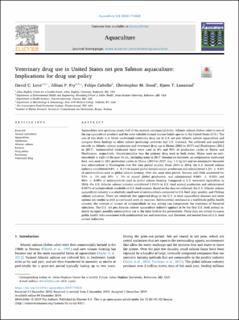| dc.description.abstract | Aquaculture now produces nearly half of the seafood consumed globally. Atlantic salmon (Salmo salar) is one of the top aquaculture products and the most valuable farmed marine finfish species in the United States (U.S.). The aim of this study is to better understand veterinary drug use in U.S. net pen Atlantic salmon aquaculture and compare these findings to other salmon producing countries and U.S. livestock. We collected and analyzed records on Atlantic salmon production and veterinary drug use in Maine (2003 to 2017) and Washington (2012 to 2017). Antimicrobial medicated feeds were used in 8% and 93% of production cycles in Maine and Washington, respectively. Oxytetratcycline was the primary drug used in both states. Maine used no antimicrobials in eight of the past 15 yrs., including none in 2017. Emamectin benzoate, an antiparasitic medicated feed, was used in 28% production cycles in Maine (2014 to 2017; avg. 1.1 kg/yr) and no emamectin benzoate was administered in Washington over the time period studied. From 2014 to 2016, the U.S. farmed salmon industry contributed 0.8% ± 0.1% to annual global farmed salmon production and administered 1.2% ± 0.6% of antimicrobials used in global salmon farming. Over the same time period, Norway and Chile accounted for 53% ± 3% and 35% ± 3% of annual global production, and administered 0.06% ± 0.02% and 96% ± 0.09% of antimicrobials used in global salmon farming. Compared to U.S. terrestrial agriculture in 2016, the U.S. Atlantic salmon industry contributed 0.031% to U.S. food animal production and administered 0.057% of antimicrobials available to U.S. food animals. Based on the data we collected, the U.S. Atlantic salmon aquaculture industry is a relatively small user of antimicrobials compared to U.S. beef, pigs, poultry, and Chilean salmon industries. There are relatively few approved drugs in the U.S. to treat aquaculture diseases and more options are needed as well as continued work on vaccines. Antimicrobial resistance is a worldwide public health concern; the overuse or misuse of antimicrobials in any setting can compromise the treatment of bacterial infections. The U.S. net pen Atlantic salmon aquaculture industry appears to be the first U.S. food animal industry to report monthly antimicrobial use at the farm-level to the government. These data are critical to assess public health risks associated with antimicrobial use and resistance, and therefore, are needed from all U.S. food animal industries. | en_US |
